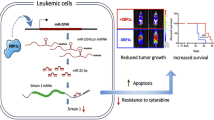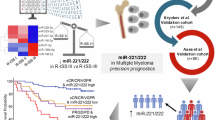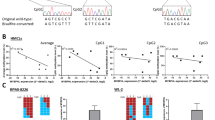Abstract
Aim:
To investigate the mechanisms by which berberine suppressed the proliferation of human multiple myeloma cells.
Methods:
Human U266 multiple myeloma cell line was tested. Cell proliferation, apoptosis, ultramicrostructure and secretion function were examined using Cell Counting Kit-8 (CCK8), flow cytometry (FCM), electron and fluorescence microscopy, as well as ELISA assay. The microRNAs (miRs) and transcription factors in U266 cells were detected using arrays and verified by qRT-PCR. EMSA and luciferase assays were used to verify the p65-dependent transactivation of miR-21 gene.
Results:
Treatment of U266 cells with berberine (40−160 μmol/L) suppressed cell proliferation and IL-6 secretion in dose- and time-dependent manners. Meanwhile, berberine dose-dependently induced ROS generation, G2/M phase arrest and apoptosis in U266 cells, and decreased the levels of miR-21 and Bcl-2. Overexpression of miR-21 counteracted berberine-induced suppression of cell proliferation and IL-6 secretion. In U266 cells treated with berberine (80 μmol/L), the activity of NF-κB was decreased by approximately 50%, followed by significant reduction of miR-21 level. berberine (80−160 μmol/L) increased the level of Set9 (lysine methyltransferase) by more than 2-fold, caused methylation of the RelA subunit, which inhibited NF-κB nuclear translocation and miR-21 transcription. In U266 cells treated with berberine (80 μmol/L), knockdown of Set9 with siRNAs significantly increased NF-κB protein level accompanying with a partial recovery of proliferation.
Conclusion:
In U266 cells, berberine suppresses NF-κB nuclear translocation via Set9-mediated lysine methylation, leads to decrease in the levels miR21 and Bcl-2, which induces ROS generation and apoptosis.
Similar content being viewed by others
Log in or create a free account to read this content
Gain free access to this article, as well as selected content from this journal and more on nature.com
or
References
Katanoda K, Saika K . Comparison of time trends in multiple myeloma mortality (1990–2006) between countries based on the WHO mortality database. Jpn J Clin Oncol 2011; 41: 444–5.
Yin J, Zhang H, Ye J . Traditional chinese medicine in treatment of metabolic syndrome. Endocr Metab Immune Disord Drug Targets 2008; 8: 99–111.
Kuo CL, Chi CW, Liu TY . The anti-inflammatory potential of berberine in vitro and in vivo. Cancer Lett 2004; 203: 127–37.
Lin JP, Yang JS, Wu CC, Lin SS, Hsieh WT, Lin ML, et al. Berberine induced down-regulation of matrix metalloproteinase-1, -2 and -9 in human gastric cancer cells (SNU-5) in vitro. In Vivo 2008; 22: 223–30.
Tang J, Feng Y, Tsao S, Wang N, Curtain R, Wang Y . Berberine and Coptidis rhizoma as novel antineoplastic agents: a review of traditional use and biomedical investigations. J Ethnopharmacol 2009; 126: 5–17
Yount G, Qian Y, Moore D, Basila D, West J, Aldape K, et al. Berberine sensitizes human glioma cells, but not normal glial cells, to ionizing radiation in vitro. J Exp Therapeutics Oncol 2004; 4: 137–43.
Lin CC, Kao ST, Chen GW, Chung JG . Berberine decreased N-acetylation of 2-aminofluorene through inhibition of N-acetyltransferase gene expression in human leukemia HL-60 cells. Anticancer Res 2005; 25: 4149–55.
Yu FS, Yang JS, Lin HJ, Yu CS, Tan TW, Lin YT, et al. Berberine inhibits WEHI-3 leukemia cells in vivo. In Vivo 2007; 21: 407–12.
Lin CC, Kao ST, Chen GW, Ho HC, Chung JG . Apoptosis of human leukemia HL-60 cells and murine leukemia WEHI-3 cells induced by berberine through the activation of caspase-3. Anticancer Res 2006; 26: 227–42.
Wu SN, Yu HS, Jan CR, Li HF, Yu CL . Inhibitory effects of berberine on voltage- and calcium-activated potassium currents in human myeloma cells. Life Sci 1998; 62: 2283–94
Kim S, Kim Y, Kim JE, Cho KH, Chung JH . Berberine inhibits TPA-induced MMP-9 and IL-6 expression in normal human keratinocytes. Phytomedicine 2008; 15: 340–7.
Shin VY, Jin H, Ng EK, Cheng AS, Chong WW, Wong CY, et al. NF-PE targets miR-16 and miR-21 in gastric cancer: involvement of prostaglandin E receptors. Carcinogenesis 2011; 32: 240–5.
Liu Q, Jiang H, Liu Z, Wang Y, Zhao M, Hao C, et al. Berberine radiosensitizes human esophageal cancer cells by downregulating homologous recombination repair protein RAD51. PLoS One 2011; 6: e23427.
Choi YS, Park JA, Kim J, Rho SS, Park H, Kim YM, et al. Nuclear IL-33 is a transcriptional regulator of NF-κB p65 and induces endothelial cell activation. Biochem Biophys Res Commun 2012; 421: 305–11.
Iizuka N, Hazama S, Yoshimura K, Yoshino S, Tangoku A, Miyamoto K, et al. Anticachectic effects of the natural herb Rhizoma Coptidis and berberine on mice bearing colon 26/clone 20 adenocarcinoma. Int J Cancer 2002; 99: 286.
Iizuka N, Miyamoto K, Hazama S, Yoshino S, Yoshimura K, Okita K, et al. Anticachectice ffects of Rhizoma Coptidis, ananti-inflammatory herb, ones ophageal cancer cells that produce interleukin 6. Cancer Lett 2000; 158: 35.
Zipori D . The hemopoietic stem cell niche versus the microenvironment of the multiple myeloma-tumor initiating cell. Cancer Microenviron 2010; 3: 15–28.
Xie JY, Li MX, Xiang DB, Mou JH, Qing Y, Zeng LL, et al. Elevated expression of APE1/Ref-1 and its regulation on IL-6 and IL-8 in bone marrow stromal cells of multiple myeloma. Clin Lymphoma Myeloma Leuk 2010; 10: 385–93.
Li B, Fu J, Chen P, Zhuang W . Impairment in immunomodulatory function of mesenchymal stem cells from multiple myeloma patients. Arch Med Res 2010; 41: 623–33.
Lin SS, Chung JG, Lin JP, Chuang JY, Chang WC, Wu JY, et al. BBR inhibits arylamine N-acetyltransferase activity and gene expression in mouse leukemia L 1210 cells. Phytomedicine 2005; 12: 351–8.
Weyhenmeyer B, Murphy AC, Prehn JH, Murphy BM . Targeting the anti-apoptotic bcl-2 family members for the treatment of cancer. Exp Oncol 2012; 34: 192–9.
Wang Q, Zheng XL, Yang L, Shi F, Gao LB, Zhong YJ, et al. Reactive oxygen species-mediated apoptosis contributes to chemosensitization effect of saikosaponins on cisplatin-induced cytotoxicity in cancer cells. J Exp Clin Cancer Res 2010; 29: 159.
Feugang JM, Ye F, Zhang DY, Yu Y, Zhong M, Zhang S, et al. Cactus pear extracts induce reactive oxygen species production and apoptosis in ovarian cancer cells. Nutr Cancer 2010; 62: 692–9.
Lou Y, Yang X, Wang F, Cui Z, Huang Y . MicroRNA-21 promotes the cell proliferation, invasion and migration abilities in ovarian epithelial carcinomas through inhibiting the expression of PTEN protein. Int J Mol Med 2010; 26: 819–27.
Sayed D, He M, Hong C, Gao S, Rane S, Yang Z, et al. MicroRNA-21 is a downstream effector of AKT that mediates its antiapoptotic effects via suppression of Fas ligand. J Biol Chem 2010; 285: 20281–90.
Bhatti I, Lee A, James V, Hall RI, Lund JN, Tufarelli C, et al. Knockdown of microRNA-21 inhibits proliferation and increases cell death by targeting programmed cell death 4 (PDCD4) in pancreatic ductal adenocarcinoma. J Gastrointest Surg 2011; 15: 199–208.
Shi L, Chen J, Yang J, Pan T, Zhang S, Wang Z, et al. MiR-21 protected human glioblastoma U87MG cells from chemotherapeutic drug temozolomide induced apoptosis by decreasing Bax/Bcl-2 ratio and caspase-3 activity. Brain Res 2010; 1352: 255–64.
Ma X, Becker Buscaglia LE, Barker JR, Li Y . MicroRNAs in NF–kappaB signaling. J Mol Cell Biol 2011; 3: 159–66.
Zhou R, Hu G, Gong AY, Chen XM . Binding of NF-kappaB p65 subunit to the promoter elements is involved in LPS-induced transactivation of miRNA genes in human biliary epithelial cells. Nucleic Acids Res 2010; 38: 3222–32.
Niu J, Shi Y, Tan G, Yang CH, Fan M, Pfeffer LM, et al. DNA damage induces NF-κB-dependent microRNA-21 up-regulation and promotes breast cancer cell invasion. J Biol Chem 2012; 287: 21783–95.
Ruan Q, Wang T, Kameswaran V, Wei Q, Johnson DS, Matschinsky F, et al. The microRNA-21-PDCD4 axis prevents type 1 diabetes by blocking pancreatic beta cell death. Proc Natl Acad Sci U S A 2011; 108: 12030–5.
Marquez RT, Wendlandt E, Galle CS, Keck K, McCaffrey AP . MicroRNA-21 is upregulated during the proliferative phase of liver regeneration, targets Pellino-1, and inhibits NF-kappaB signaling. Am J Physiol Gastrointest Liver Physiol 2010; 298: G535–41.
Hayden MS, Ghosh S . Shared principles in NF-κB signaling. Cell 2008; 132: 344–62.
Ko S, Ahn J, Song CS, Kim S, Knapczyk-Stwora K, Chatterjee B . Lysine methylation and functional modulation of androgen receptor by Set9 methyltransferase. Mol Endocrinol 2011; 25: 433–44.
Yang J, Huang J, Dasgupta M, Sears N, Miyagi M, Wang B, et al. Reversible methylation of promoter-bound STAT3 by histone-modifying enzymes. Proc Natl Acad Sci U S A 2010; 107: 21499–504.
Gaughan L, Stockley J, Wang N, McCracken SR, Treumann A, Armstrong K, et al. Regulation of the androgen receptor by SET9-mediated methylation. Nucleic Acids Res 2011; 39: 1266–79.
Yang XD, Tajkhorshid E, Chen LF . Functional interplay between acetylation and methylation of the RelA subunit of NF-kappaB. Mol Cell Biol 2010; 30: 2170–80.
Ea CK, Baltimore D . Regulation of NF-kappaB activity through lysine monomethylation of p65. Proc Natl Acad Sci U S A 2009; 106: 18972–7.
Yang XD, Huang B, Li M, Lamb A, Kelleher NL, Chen LF . Negative regulation of NF-kappaB action by Set9-mediated lysine methylation of the RelA subunit. EMBO J 2009; 28: 1055–66.
Acknowledgements
This paper was supported by Guangdong Science and Technology Plan (No 2012A030400012).
Author information
Authors and Affiliations
Corresponding authors
Rights and permissions
About this article
Cite this article
Hu, Hy., Li, Kp., Wang, Xj. et al. Set9, NF-κB, and microRNA-21 mediate berberine-induced apoptosis of human multiple myeloma cells. Acta Pharmacol Sin 34, 157–166 (2013). https://doi.org/10.1038/aps.2012.161
Received:
Accepted:
Published:
Issue date:
DOI: https://doi.org/10.1038/aps.2012.161
Keywords
This article is cited by
-
Advanced application of nanotechnology in active constituents of Traditional Chinese Medicines
Journal of Nanobiotechnology (2023)
-
Tumor-suppressive functions of protein lysine methyltransferases
Experimental & Molecular Medicine (2023)
-
Discovery of the oncogenic MDM2, a direct binding target of berberine and a potential therapeutic, in multiple myeloma
Functional & Integrative Genomics (2022)
-
RETRACTED ARTICLE: Berberine reduces temozolomide resistance by inducing autophagy via the ERK1/2 signaling pathway in glioblastoma
Cancer Cell International (2020)



